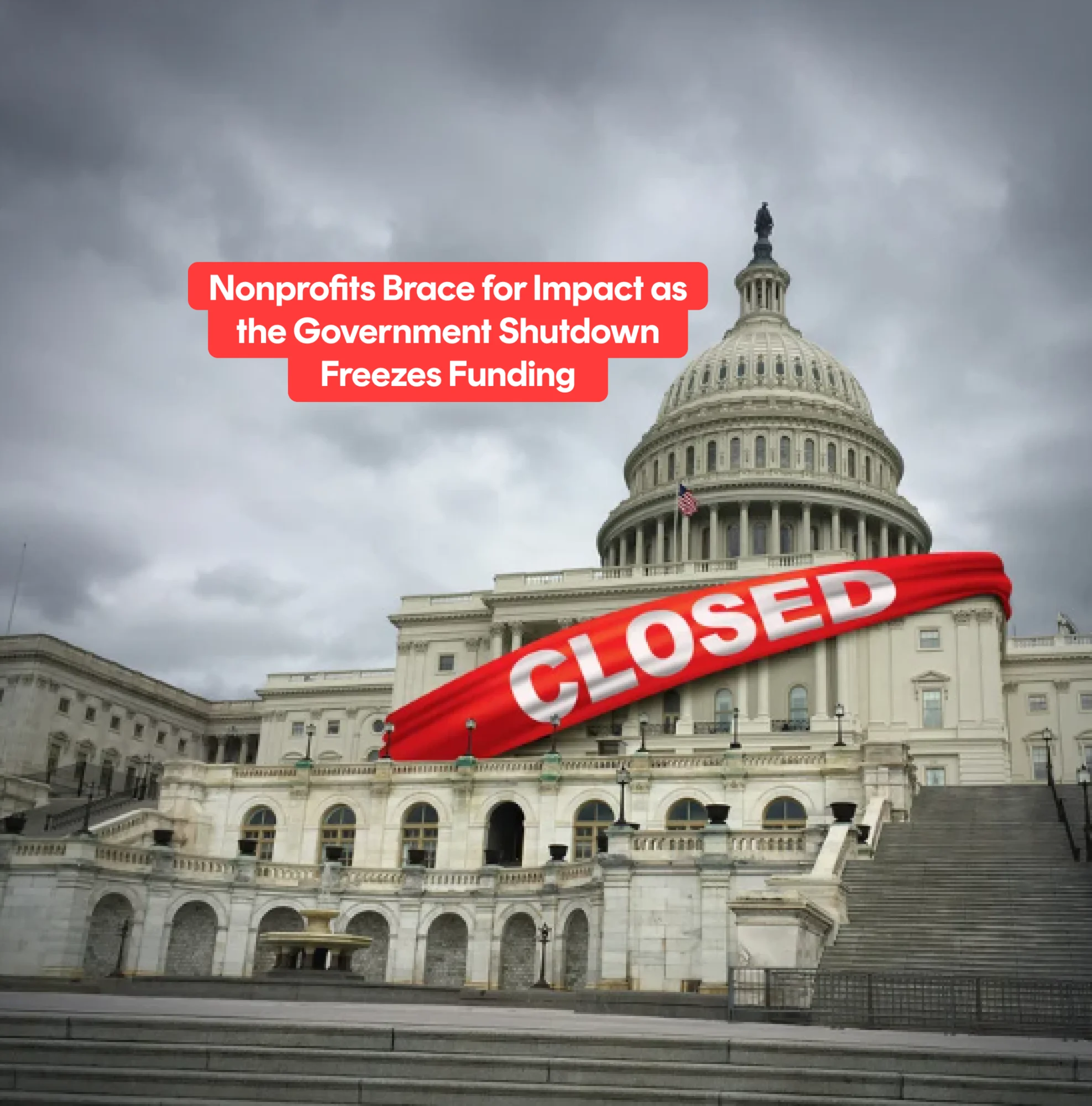Nonprofit Financial Hub

Surviving the Shutdown: Smart Funding Moves for Nonprofits Right Now
This article discusses how shutdowns can affect nonprofit funding and cash flow and describes various approaches nonprofits may use to address these challenges. B Generous is one option that can help organizations manage financial gaps when grant payments and reimbursements are delayed or suspended.
The Ripple Effects of a Government Shutdown on Nonprofits
About 68% of US nonprofits have some form of government financial assistance, making a government shutdown extremely damaging to the nonprofit sector. Here are some of the ways that a government shutdown impacts the finances of the nonprofit sector.
Frozen Payments & Delayed Reimbursements
Many nonprofits operate under reimbursable grant contracts with federal agencies. Under a shutdown, federal employees responsible for reviewing invoices and approving reimbursements are often furloughed, meaning payments stall until the government reopens.
Even grants already awarded may face delays in disbursement or drawdowns, putting nonprofits in the precarious position of having already delivered services without being paid.

New Funding Opportunities On Hold
Shutdowns slow or stop the review and awarding of new federal grants. Proposal review panels don’t convene, federal program staff are unavailable, and notices of new funding opportunities may be delayed or canceled. That means nonprofits anticipating new funds for programs or expansions suddenly face uncertainty.
Projects Stall & Costs Rise
Longer-term capital or infrastructure projects funded with federal dollars may be put on hold midstream. Permitting, oversight, and contracting processes get delayed. Meanwhile, inflation or cost escalation can make projects more expensive the longer the pause lasts, and subcontractors may impose penalties for late payments.
Demand Increases While Resources Shrink
When federal assistance is unavailable, individuals and families often seek help from nonprofit organizations. Disruptions to unemployment benefits, housing relief, food subsidies, or disaster assistance can result in increased demand for nonprofit services at times when these organizations have diminished resources. In fact, at the same time demand is rising, many nonprofits may have to cut back services, suspend programs, or lay off staff to survive the cash crunch.
Public-Private Partnerships Get Interrupted
Many nonprofits partner with government agencies to deliver programs. A shutdown can erode those partnerships meaning contracts are delayed, collaboration slows, and some relationships may suffer.
Widespread Program Impact
The impact of the government shutdown will be felt across the entire nonprofit sector. Here are just a few examples:
Domestic violence and victim services – The Department of Justice’s grant offices have been furloughed in past shutdowns, delaying awards and technical assistance.
Food Assistance & Nutrition Programs – Many nonprofits depend on federal reimbursements or grants through USDA and related agencies. During a shutdown, payments pause even if the nonprofits keep feeding people. There is actually often a surge in demand at food banks and pantries as government benefits are delayed.
Cultural institutions, museums, and national parks – Programs relying on federal grants or oversight may cancel exhibitions, close sites, or suspend educational outreach.
Community Health & Clinics – Federally Qualified Health Centers (FQHCs) and nonprofit clinics are largely dependent on government grants for their operations. When clinics serving uninsured populations experience reimbursement delays, there can be significant challenges related to maintaining adequate staffing and supplies. Essential programs, such as addiction treatment and behavioral health services, may be disrupted or cancelled as a result.
What Nonprofits Can Do Now
Yes, a shutdown is disruptive, but there are important steps nonprofits can take to increase resilience and financial stability:
- Review your cash flow and liquidity – budget cash flow for about 2 weeks
Project how long your reserves will last under different scenarios (e.g., 2-week, 4-week, 8-week shutdown). Identify critical expenses (payroll, utilities, rent, core program delivery) vs. discretionary ones. In the past, the average government shutdown lasted about 8 days, although it is prudent for nonprofits to budget longer as it takes time for things to start flowing again even after the shutdown has ended. There have been 21 government shutdowns since 1976 when this budgeting process began, and most of the early shutdowns last 3 days or less, but more recently that average has grown to 8 days, and may grow longer.
- Prioritize essential services
Decide which programs must continue, which can scale back temporarily, and which may need to pause until funding returns.
- Communicate openly and proactively with funders and partners
Inform grantors, donors, board members, vendors, agencies, and partners about your financial projections and plan during the shutdown. The earlier you communicate your needs and wants, the better the outcome will be. Be transparent and candid about your cash flow needs.
- Look for “force majeure” or “government shutdown” clauses in your vendor contracts
Many vendors will offer flexible payment terms to nonprofits during a shutdown. More importantly, many vendor contracts have “force majeure” or “government shutdown” clauses in them which explicitly allow for delayed payment. In many contracts, government inaction is a valid excuse for delayed payment and even if not explicitly mentioned, a shutdown can sometimes qualify under “governmental acts or omissions beyond the party’s control”
- Diversify revenue sources
Increase efforts in private fundraising, engage individual donors, seek corporate partnerships, and pursue non-federal grants to mitigate reliance on government funding.
- Seek bridge financing or lines of credit
A short-term bridge loan or line of credit may provide critical financial flexibility during reimbursement delays. The B Generous lending marketplace is specifically tailored to meet the needs of nonprofit borrowers for this purpose
- Advocate and stay informed
Track congressional updates, connect with nonprofit advocacy and trade groups to see how you can help put pressure on Congress to end the shutdown (e.g. National Council of Nonprofits, Nonprofit Alliance, Independent Sector etc.), and most importantly encourage your local congressional representative to resolve the shutdown.
- Plan for the long term
Use this as an impetus to build reserves, set up contingency funds, and embed flexibility into your budget and operations going forward. Consider applying for a line of credit as a good future solution to short term liquidity disruptions like a government shutdown. The B Generous marketplace offers more lines of credit to nonprofits than any other company in the United States.
How B Generous Can Be a Part of the Solution
While the forces of federal funding are outside any single organization’s control, B Generous offers a tool for nonprofits that can help mitigate liquidity disruptions and cash flow stress during times of political instability in DC.
B Generous has created the nation’s largest online lending marketplace dedicated exclusively to nonprofit organizations. B Generous provides nonprofits and charitable organizations with access to immediate capital, so nonprofits can focus on their mission at hand and worry less about fundraising. Through our industry-leading nonprofit lending marketplace, nonprofits can secure capital quickly and efficiently. Best of all, there are no costs or fees whatsoever to apply for a loan or line of credit. It is completely free to apply, and it generally takes less than 30 minutes to complete an application. Nonprofits can get approved for up to $50 Million in capital through the B Generous lending marketplace.
Since launching our Nonprofit Lending Marketplace in early 2024, we have received over $1 billion in loan requests from over 30,000 nonprofits, and we have already approved almost $100 million in loans, and are hard at work approving more every day. Our loans fund a variety of amazing nonprofit programs, initiatives, and organizations, and generate real impact in the world today.
If you want to learn more or submit a loan request please visit
https://bgenerous.com/accelerate/
Conclusion
A government shutdown creates real hardship in communities across the country, especially through disrupted nonprofit services. Nonprofits rely on timely grant payments, steady cash flow, and predictable funding to serve the vulnerable. When that support slows down or stops, mission-critical services are at risk.
Nonprofits can respond proactively by managing cash wisely, communicating transparently with donors and funders, planning wisely for future disruptions, building financial capital reserves, negotiating payment terms with vendors, diversifying income sources, and using the credit markets to secure interim funding or bridge loans in times of need. Visit BGenerous.com to learn how you can secure the capital you need to ensure your nonprofit will continue to thrive during this government shutdown. The B Generous marketplace structures loans and lines of credit from $50K – $50M to nonprofits for virtually any capital need.
Disclaimer: This article is for educational purposes only and should not be construed as financial, legal, or tax advice. B Generous makes no guarantees about the accuracy or completeness of the information, and readers should consult with qualified professionals before making financial decisions.



